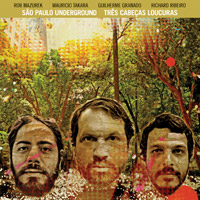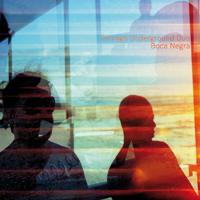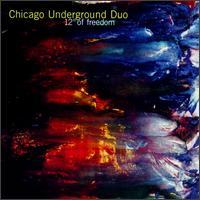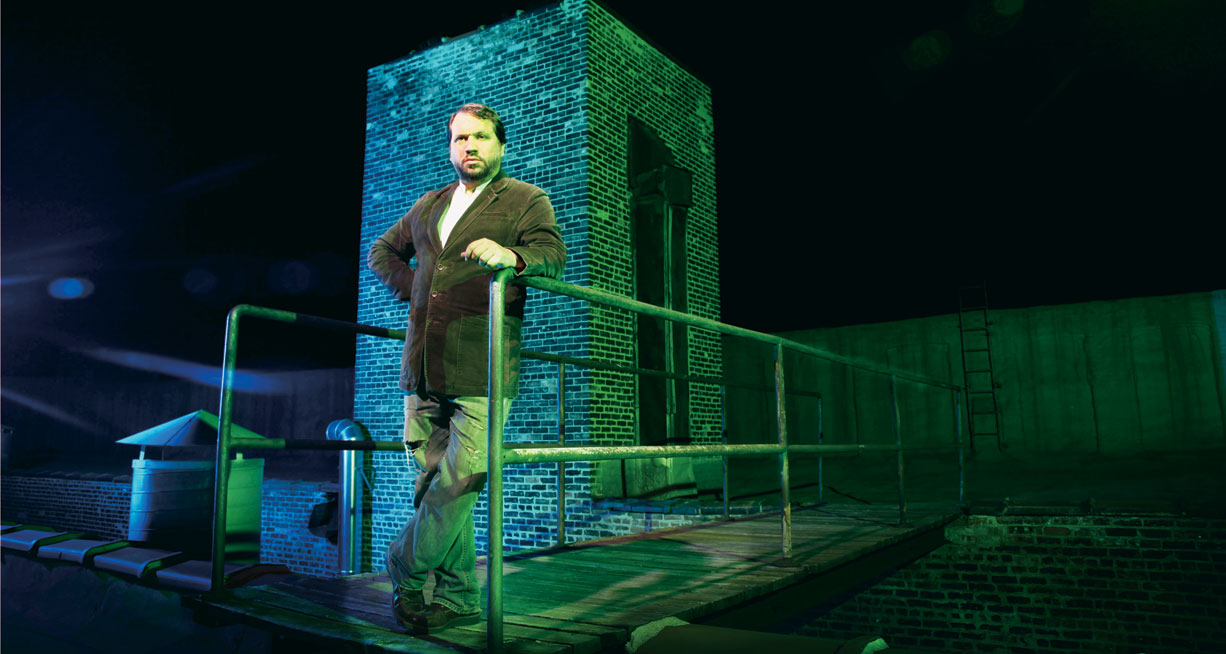 São Paulo Underground: Três Cabeças Loucuras (Cuneiform Records, 10/11/11)
São Paulo Underground: Três Cabeças Loucuras (Cuneiform Records, 10/11/11)
São Paulo Underground: “Jagoda’s Dream”
[audio:https://alarm-magazine.com/wp-content/uploads/2011/10/SPU_Jagoda.mp3|titles=Sao Paulo Underground: “Jagoda’s Dream”]“The sound you do not hear but see, and the visual you cannot see but hear, is the work,” says Rob Mazurek. “The rest is up to the imagination.” That sentiment shouldn’t be surprising to fans of the prolific cornet player, composer, and Chicago-based avant-garde luminary. His entire two-decade career has been an adventure in experimentation, and he serves as a gravitational hub around which dozens of bright talents orbit as members of his various ensembles. At present, Mazurek is the leader of the compact duo and trio versions of Chicago Underground; its antipodal counterpart, São Paulo Underground; the expansive, sprawling Exploding Star Orchestra; and the nascent Sound Is Quintet. Though his various projects all offer unique perspectives on sound and structure, they’re all propelled at some level by Mazurek’s fascination with the visual and often seek out new sounds through the expressive manipulation of color.
Imagination is an important part of Mazurek’s methods. His compositions exist in a dreamy world that incorporates elements of jazz, post-rock, electronic music, and noise, drifting, floating weightlessly in a limbo that practically demands the listener to dive deeply into the piece and create form in the spaces and gaps left open. Mazurek isn’t content to let the listener have all the fun, however, and facilitates imagination not just in the consumption of his work but also in its conception. On many of his albums, he uses unorthodox methods of composition and conducting to imbue his sounds with new passion and flavor, and color plays a significant role in that mission.
 “Recently, I used a sequence of square paintings with a very specific layering of color ― graphite, white, red, and green,” Mazurek says. These paintings were to serve as visual prompts for his ensemble, in lieu of a traditionally written score or set of instructions. “Written music is very much what it is,” Mazurek says, with an air of exasperation. “These experiments push the player to imagine what could be there, what’s behind the obvious. It’s exciting. The top color, green, was pushing out from the painting, while the other colors were barely seen — as if inaudible. The suggestion of the reds, graphites, and whites could only be read as interpretive projections of imagined colors and textures and shades.”
“Recently, I used a sequence of square paintings with a very specific layering of color ― graphite, white, red, and green,” Mazurek says. These paintings were to serve as visual prompts for his ensemble, in lieu of a traditionally written score or set of instructions. “Written music is very much what it is,” Mazurek says, with an air of exasperation. “These experiments push the player to imagine what could be there, what’s behind the obvious. It’s exciting. The top color, green, was pushing out from the painting, while the other colors were barely seen — as if inaudible. The suggestion of the reds, graphites, and whites could only be read as interpretive projections of imagined colors and textures and shades.”
Such exercises conjure sound using color and visual treatments as an input, but Mazurek’s belief in the malleability and interchangeability of the aural and the visual has led him to work from the other end, with sound as input and color as the output. “I did a work called Music for Shattered Light Box and 7 Posters where the sound from a CD player played very specific shards of my compositions,” he says. “The sound goes into a light box and affects the light source. You do not hear the sound; you only see the effect that the sound has on the light and the shards of that light being projected through the shattered glass.” For him, the lights and colors emitted by the box is the performance. Whether or not one actually hears the music is an afterthought for him; it’s practically irrelevant. “You can take the CD and play it and hear what the sound is,” he says, “but only afterward, if you’re interested enough [by the lights].”
 Given his interest in manipulating sound and color, it’s no wonder that Mazurek considers himself a visual artist as well as a musician. “I paint,” he says. “It flows quite naturally. I see my work as a visual artist and a musician as the same at times, and at other times, completely different.” His paintings deal with bold color and shape, in their rawest forms. Highly evocative of the chromatic abstracts of Mark Rothko, these works appear simple at first glance, but closer inspection reveals layers of details and subtle inflections. Some of his work has served as album art on his Chicago Underground records, such as Axis and Alignment (2002) and Synesthesia (2000).
Given his interest in manipulating sound and color, it’s no wonder that Mazurek considers himself a visual artist as well as a musician. “I paint,” he says. “It flows quite naturally. I see my work as a visual artist and a musician as the same at times, and at other times, completely different.” His paintings deal with bold color and shape, in their rawest forms. Highly evocative of the chromatic abstracts of Mark Rothko, these works appear simple at first glance, but closer inspection reveals layers of details and subtle inflections. Some of his work has served as album art on his Chicago Underground records, such as Axis and Alignment (2002) and Synesthesia (2000).
“The paintings I made for these records are special,” he reveals, “in the sense that they are not quite what they seem. They seem like large-format paintings, when actually they are very small and done with small brushes over a long period of time.” Mazurek named the latter album for a neurological condition that can affect a person’s perception. Senses become crossed and combined in strange ways. Numbers and words can have a taste to a synesthete; months can acquire personalities, and sound can suggest color. It’s a peculiar syndrome that often results in creative, artistic types. Mazurek doesn’t claim to be a synesthete, but his belief in the intimate connection between color and sound certainly make him sympathetic to one’s worldview.
“I especially enjoy the painting on Synesthesia, where I used linseed oil under the whites to make it crack a bit and reveal underneath,” he says. “This was probably my first discovery of this idea of not revealing too much of what is underneath and to let that power shake the foundation of the painting.” These vibrant, nuanced covers are indicative of Mazurek’s artistic philosophy. All his work, regardless of medium, is geared toward discovery, and for him, music and visual art are two sides of the same coin, two ways of achieving the same goal, inexorably intertwined with one another. “Color, form, texture, power,” he says. “These ideas all seem to be applicable, in sound and in plastic.”
 This mindset was not exactly shared by Mazurek’s idol and collaborator, free-jazz legend Bill Dixon. Like Mazurek, the trumpet legend also moonlighted as a visual artist and painter, and he created the cover art for Bill Dixon with Exploding Star Orchestra, the pairing’s 2008 collaboration. Though the art is abstract, the approach is markedly different than the one that Mazurek took on his Chicago Underground covers. Whereas Mazurek’s art uses fuzzy borders and bleeding edges seeping out from large blocks of bold color, Dixon’s cover is far more structured and precise, with heavy stripes and lines of dark hues falling on top of one another but never fraternizing, always observing clear definition and distinction. This difference in artistic manner between the two horn players carried over into their views on the relationship between their visual art and their music.
This mindset was not exactly shared by Mazurek’s idol and collaborator, free-jazz legend Bill Dixon. Like Mazurek, the trumpet legend also moonlighted as a visual artist and painter, and he created the cover art for Bill Dixon with Exploding Star Orchestra, the pairing’s 2008 collaboration. Though the art is abstract, the approach is markedly different than the one that Mazurek took on his Chicago Underground covers. Whereas Mazurek’s art uses fuzzy borders and bleeding edges seeping out from large blocks of bold color, Dixon’s cover is far more structured and precise, with heavy stripes and lines of dark hues falling on top of one another but never fraternizing, always observing clear definition and distinction. This difference in artistic manner between the two horn players carried over into their views on the relationship between their visual art and their music.
Dixon, who passed away in June of 2010 at the age of 84, considered his two domains to be separate. Mazurek sees things differently, however. “I could always make my own parallels to his music and paintings,” he says. “His golden tone and striking lines, the colored nuances in his dynamic flow, the intense brightness in his upper register of the horn and cavernous blackness of the lower end. His ingenious turn of a melodic fragment and bursts of sun-flare excitement — that’s a painting right there! Anyone interested in the ideas of sound, color, and form should study his works deeply. He will be greatly missed.”
 Despite this ideological impasse, Dixon was game enough to engage in one of Mazurek’s imaginative scoring methods on the aforementioned album. The first six minutes of “Constellations for Inner Light Projections,” the album’s centerpiece, was composed using a video score that presented The Exploding Star Orchestra, which includes such notable Chicago musicians as Nicole Mitchell, Jason Adasiewicz, and Jeff Parker, with an array of colors to be interpreted by the players individually and transformed into music. The result is a curious olio of reactions that reflects the disparate emotional and sensory reactions of the musicians. “In the beginning, there was some general confusion,” Mazurek says, “but after their eyes and brains got used to the idea, wonderful things started to happen ― quite indescribable things. It has a kind of cloudy haziness, and when it breaks out of [the visual score], the piece has more of a hard sound.”
Despite this ideological impasse, Dixon was game enough to engage in one of Mazurek’s imaginative scoring methods on the aforementioned album. The first six minutes of “Constellations for Inner Light Projections,” the album’s centerpiece, was composed using a video score that presented The Exploding Star Orchestra, which includes such notable Chicago musicians as Nicole Mitchell, Jason Adasiewicz, and Jeff Parker, with an array of colors to be interpreted by the players individually and transformed into music. The result is a curious olio of reactions that reflects the disparate emotional and sensory reactions of the musicians. “In the beginning, there was some general confusion,” Mazurek says, “but after their eyes and brains got used to the idea, wonderful things started to happen ― quite indescribable things. It has a kind of cloudy haziness, and when it breaks out of [the visual score], the piece has more of a hard sound.”
On deck for Mazurek is a particularly ambitious project, even for a seasoned veteran like him: a 10-volume set of music for his partner’s new label, Sun Core Records, that further elaborates upon his theories on the link between light, color, and sound. “I have been working with the folks at La Grande Fabrique [recording studio] in Dieppe, France on this goal,” he says. “This is their area of expertise, and with their technology, I am creating video pieces and sound pieces built entirely on this premise, juxtaposing each on the other and creating a whole different universe. It’s quite exhilarating.”
Mazurek calls the potential for such juxtapositions “endless,” and indeed, his inspirational compositions are drawn from a colorful palette that appears to be inexhaustible. As he delves deeper and deeper into the visible spectrum, pulling out shards of sound from little-investigated regions, we can only imagine what will follow — and that might be Mazurek’s true goal after all.

